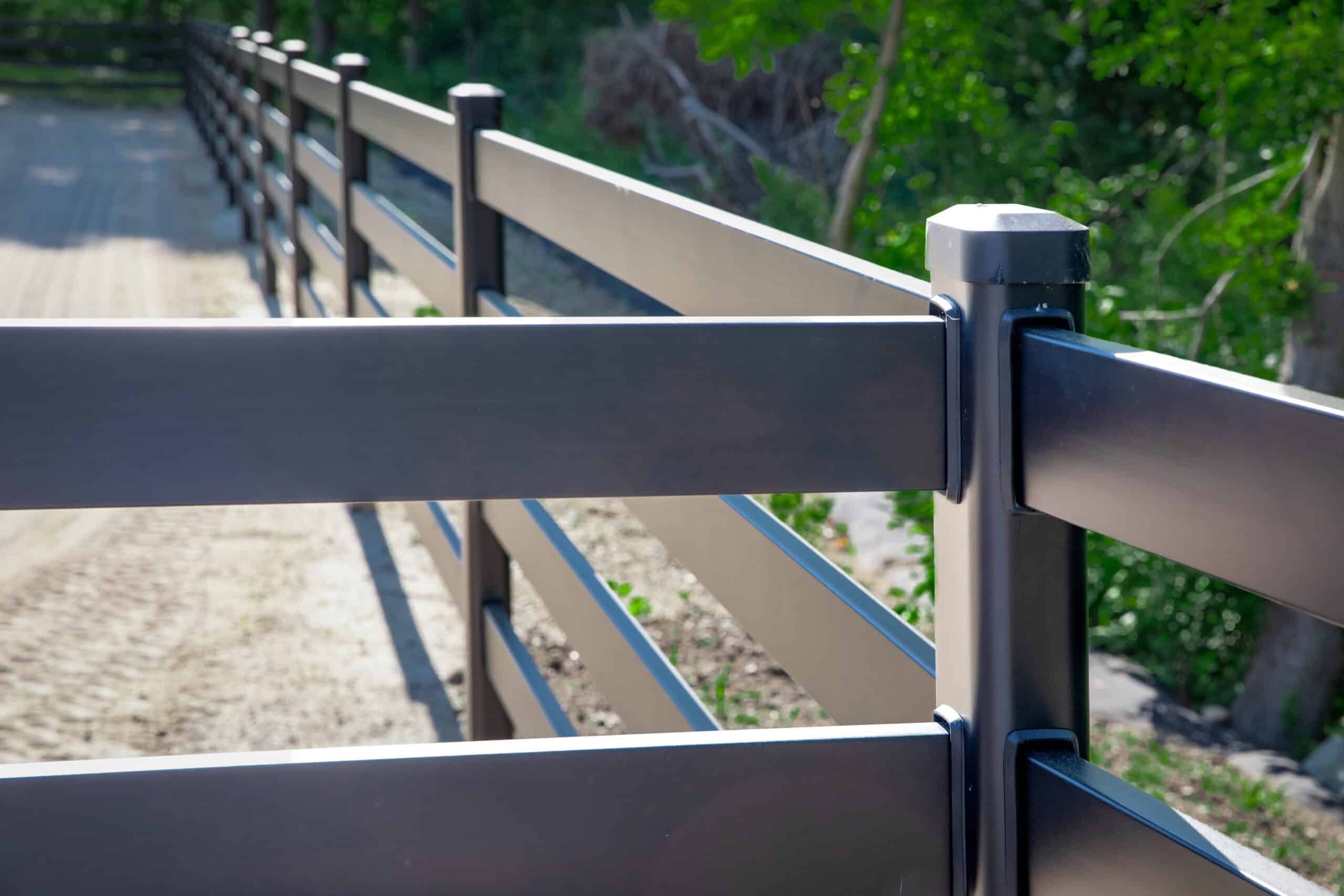Your gate is the handshake of your property: the first impression that sets the tone for everything beyond. And for those of us who’ve spent our lives working land and raising horses, we understand that not just any gate will do.
Split rail gates have earned their place on ranches and equestrian properties for good reason. They’re not trendy or flashy. They’re honest. They combine strength with a certain dignity that seems to grow more handsome with age, much like the weathered hands that operate them daily.
But here’s what decades in the fencing business have taught us: while split rail looks the part, it doesn’t always perform when it matters most.
At Buckley, we’ve built our reputation listening to folks who know what it means when a gate fails during calving season or when you’re trying to load horses in the rain. We’ve heard the frustrations with traditional split rail—the warping, the maintenance, the eventual replacement. That’s why we’ve developed Steel Board Fencing as the superior alternative that gives you everything you love about the split rail aesthetic with the performance you actually need.
Every day. Every season. Every year.
We understand that for serious property owners, a gate isn’t an afterthought. It’s an investment. One that should stand strong through harsh winters, unrelenting summers, and everything Mother Nature throws at it. One that should still be standing tall when you eventually pass your property down to the next generation.
That’s why we believe there’s a better way than traditional split rail—one that honors the classic look while delivering modern performance.
What Is a Split Rail Fence Gate?
A split rail gate consists of horizontal rails secured within a sturdy frame, creating a design that’s simultaneously simple and substantial. Traditional split rail fencing uses posts that are literally split from round logs—usually cedar or locust—creating that authentic rustic appearance that’s been part of American agricultural heritage for generations.
These gates typically stand between 4 and 5 feet tall with 3 to 4 horizontal rails depending on your containment needs. The appeal is obvious: they’re honest, straightforward, and have that weathered dignity that comes from working with natural materials.
For horse owners, split rail gates offer good visibility, allowing your animals to see through them and reducing anxiety. The horizontal rail design is familiar and comfortable for horses, which is why you’ll see variations of it on properties across the country.
But here’s where experience separates the ideal from the reality. Traditional wood split rail gates, while attractive, face some serious challenges. Wood warps. It splits. It requires constant maintenance. Those beautiful cedar rails that look so perfect on installation day? Give them a few seasons of weather, and you’ll be dealing with gaps, splinters, and gates that no longer hang straight.
We’ve seen it countless times: property owners start with split rail because they love the look, then find themselves replacing rails, re-hanging gates, and fighting with latches that stick or fail. The maintenance schedule alone—annual staining, replacing rotted sections, adjusting sagging hardware—can turn that classic aesthetic into a costly headache.
Quality matters here. When you’re bringing in hay during a threatening storm or moving nervous horses between pastures, you don’t have time for sticking gates or failing latches. You need something that operates smoothly year after year, through freezing winters and baking summers alike.
The Best Split Rail Gate Designs (and Why Steel Board Is Better)
Traditional split rail gates come in several configurations, each with their own appeal and limitations. Understanding these options—and their drawbacks—helps explain why we developed Steel Board Fencing as the superior alternative.
1. Traditional Three-Rail Split Rail Gates
The classic three-rail configuration provides decent visibility and containment for most horse breeds. Standing at 4’6″, this design allows horses to see clearly through the gate while providing basic security. The three horizontal rails are spaced to prevent most horses from reaching through or over.
- The Problem: Traditional wooden three-rail gates are prone to warping, especially the top and bottom rails which bear the most stress. Within a few seasons, you’ll often see gaps develop where rails pull away from posts, creating both security and safety concerns.
- The Buckley Solution: Our Steel Board Gates deliver the same clean, horizontal aesthetic but with galvanized steel construction that maintains perfect alignment year after year. Available in textured black or gloss white, they provide the classic look without the maintenance headaches.
2. Four-Rail Traditional Design
For properties with smaller horses, foals, or those requiring maximum security, traditional four-rail gates add an additional horizontal rail. This configuration prevents smaller animals from ducking under or through while maintaining visibility.
- The Problem: More rails mean more places for wood to warp, split, or pull loose. Four-rail wooden gates often develop the classic “bellied” appearance as individual rails bow outward under stress and weather exposure.
- The Buckley Solution: Our Steel Board design maintains precise rail spacing and alignment regardless of weather conditions. Each rail is engineered to handle the specific stresses horses place on fencing, from scratching to leaning.
3. Single and Double Gate Configurations
Traditional split rail gates can be installed individually or as doubles to accommodate different access needs—from daily horse turnout to occasional equipment passage.
- The Problem: Double wooden gates present twice the maintenance challenges, and getting them to align properly after seasonal movement becomes an ongoing frustration. Sagging is almost inevitable.
- The Buckley Solution: Our unique mounting system allows each Steel Board gate to rest on top of a separate steel tubing post set in concrete. This engineering eliminates the stress points that cause traditional hinged gates to sag and ensures double gates maintain perfect alignment.
How to Choose the Right Materials for Your Split Rail Gate
The material you choose for your split rail gate will determine not just how it looks on day one, but how it performs over decades of weather, wear, and daily use. Sure, tradition might point toward wood, but experience has shown us that modern materials offer major advantages for serious property owners who value longevity and reduced maintenance.
Let’s compare your options and look at what matters most when your gate needs to stand up to horses, weather, and time:
| Material | Durability | Maintenance | Appearance | Safety | Lifespan | Cost Over Time |
| Galvanized Steel | Exceptional resistance to impact, warping, and weather | Minimal – occasional cleaning only | Modern interpretation of classic design with clean lines | No splintering, consistent strength | 30+ years | Highest initial investment, lowest long-term cost |
| Wood (Cedar/Pine) | Prone to warping, splitting, and decay | High – annual staining/sealing required | Traditional rustic appearance that weathers over time | Can splinter, weaken with age | 7-10 years with maintenance | Low initial cost, high replacement frequency |
| Vinyl/PVC | Good weather resistance, poor impact resistance | Low – occasional cleaning | Artificial appearance, limited color options | Becomes brittle in extreme cold, can shatter on impact | 15-20 years | Moderate initial cost, eventual replacement needed |
| Aluminum | Good weather resistance, less impact resistant than steel | Low – occasional cleaning | Similar to steel but lighter profile | No splintering, can bend under pressure | 20+ years | High initial cost, moderate long-term value |
Practical Considerations for Horse Owners
Here’s what you need to consider for your gate if you’ve got horses to take care of:
- Safe Spacing Design: The space between rails matters more than most realize. Our gates feature precisely calculated spacing that prevents curious horses from getting hooves or heads caught between rails (a common injury risk with poorly designed gates). For properties with foals or miniature breeds, our four-rail configuration provides additional security without sacrificing visibility.
- Latch Reliability: A gate is only as secure as its latch. Our EZ Latch system operates smoothly with one hand (even with gloves on) and secures automatically when the gate closes. Unlike traditional latches that freeze or stick, ours maintains consistent performance through all seasons and weather conditions.
- Opening Mechanism: The way your gate opens and closes might seem minor until you’re dealing with it multiple times daily. Our unique bearing system allows the gate to rest on top of the post rather than hanging from hinges, eliminating the sagging and dragging that plague traditional gates. The result is smooth, quiet operation that never requires lifting or forcing, even after years of use.
- Width Considerations: Access requirements should drive your gate width decision. Standard 4-foot gates work well for daily horse turnout, but consider 8-foot or double 12-foot options if you need to move equipment or vehicles through occasionally. Proper sizing prevents unnecessary wear on both your gate and surrounding fence posts from tight maneuvering.
- Post Foundation: The strongest gate will fail if mounted to inadequate posts. Our separate steel tubing gate posts are designed to be set in concrete at precise depths based on your soil conditions. This foundation approach provides stability that wood posts simply cannot match, guaranteeing your gate remains level and functional regardless of ground movement from freeze/thaw cycles or moisture changes.
Build Once, Build Right
When you’ve put your heart into your property and your horses, you deserve gates that honor that commitment. Buckley Steel Board Gates aren’t just built differently—they’re engineered to be the last gates you’ll ever need to purchase for your property. Our combination of premium materials, thoughtful design, and horse-focused functionality creates entrances that work through decades of daily use.
When it comes to your property’s entrances, compromise is never the answer.



